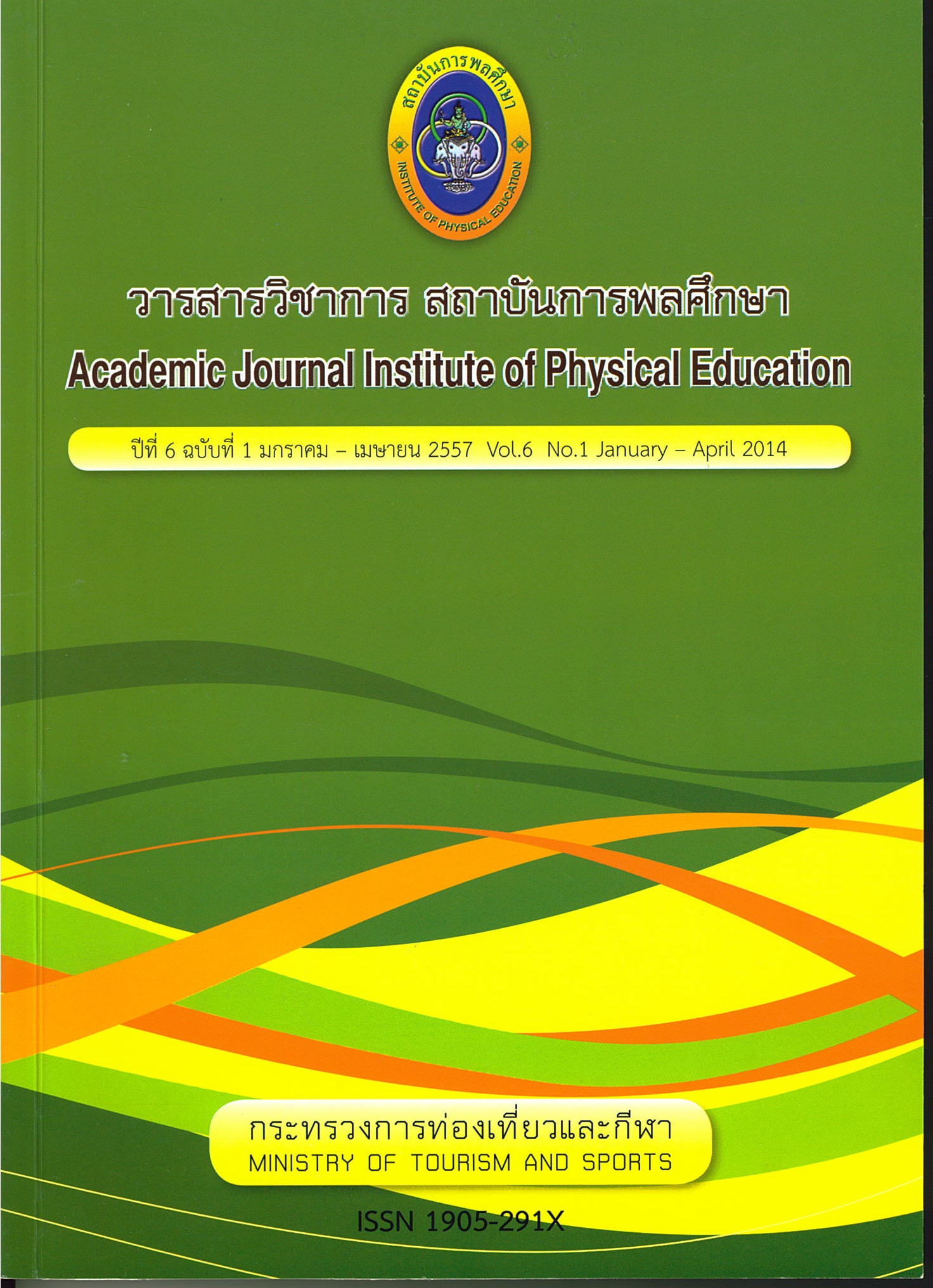Expectations and the reality of knowledge and skills in Research Competency for Faculties of Physical Education Institutes in the North
Main Article Content
Abstract
The purpose of this study was to examine the research context of the northern institute of physical education and to compare the realistic and expected condition, knowledge, and skills among the northern IPE instructors. The sample included northern IPE instructors of the year 2013. The sample size was calculated using the Darwin Hendel's random sampling Table. Data was gathered from one hundred and two samples. The Stratified Random Sampling and Simple Random Sampling were used to select the samples. The research instrument composed 1) questionnaires enquiring about the relevant research context by the northern IPE instructors and 2) realistic and expected estimation inventory for condition, knowledge, and skills among the northern IPE instructors. The content validity was conducted by three experts; all found internal consistency at 0.67- 1.00. The internal reliability was conducted using the Cronbach's Alpha Reliability Coefficient; 0.945 for the research context of the northern institute of physical education and 0.985 for realistic and expected condition, knowledge, and skills among the northern IPE instructors. For data analysis, the frequency, percentage, mean (7), standard deviation (S.D.) were used. To compare the realistic and expected condition, knowledge, and skills among the northern IPE instructors, the Paired-Sample t-test was used.
The results show as follows.
- The northern IPE instructors were of the opinion toward research promotion policy moderately (
= 2.97, SD. = 0.83), research-contributing condition moderately (
= 2.68, SD. = 0.88), research personnel moderately (
= 2.81, SD. = 0.95), and number of regional researches moderately (
= 2.52, SD. = 0.86).
- To compare means between knowledge and skill, and realistic and expected condition in the northern IPE instructors, the Paired-Sample t-test results show the statistically significant difference at .05. Data analysis indicated that means knowledge and skill relating to current research conducting was lower than that of expected research conducting in all respect of areas.
Article Details

This work is licensed under a Creative Commons Attribution-NonCommercial-NoDerivatives 4.0 International License.
The published article is a copyright of the Academic Journal of Thailand National Sports University. The passage appeared in each article in this academic journal is a perspective of each author which is not related to the journal. Each author is required to be responsible for all components of his/her own article. If there are any mistakes, each author must be responsible for those mistakes on his/her own.
References
เกียรติสุดา ศรีสุข. (2552), ระเบียบวิธีวิจัย, พิมพ์ครั้งที่ 2. เชียงใหม่ : โรงพิมพ์ ครองช่าง.
จิรประภา อัครบวร. (2549). สร้างคนสร้างผลงาน. กรุงเทพฯ : ก.พลพิมพ์. (1996).
ชูชัย สมิทธิไกร. (2554). การฝึกอบรมบุคลากรในองค์การ. พิมพ์ครั้งที่ 7. กรุงเทพฯ : โรงพิมพ์แห่งจุฬาลงกรณ์มหาวิทยาลัย.
ณรงค์วิทย์ แสนทอง. (2547), มารู้จัก COMPETENCY กันเถอะ, กรุงเทพฯ : เอช อาร์ เซ็นเตอร์.
บุญชม ศรีสะอาด, 2545. การวิจัยเบื้องต้น, พิมพ์ครั้งที่ 6 กรุงเทพฯ : สุวีริยาสาสน์.
ประเวศ วะสี. (2552). ปฏิรูปประเทศไทย ปฏิรูประบบอุดมศึกษา อุดมศึกษาคือหัวรถจักรทางปัญญาพาชาติออกจากวิกฤต. กรุงเทพฯ : บ. ที่คิว พี่จก.
พันธุ์ศักดิ์ โรจนากาศ. (2550). การพัฒนาศักยภาพในการผลิตช่างแม่พิมพ์ของสํานักงานคณะกรรมการการอาชีวศึกษา กรุงเทพฯ : สํานักงานคณะกรรมการการอาชีวศึกษา กระทรวงศึกษาธิการ.
เพ็ชรี รูปะวิเชตร์. (2554). เทคนิคการจัดฝึกอบรมและการประชุม. กรุงเทพฯ : ดวงกมลพับลิสซิ่ง.
มานิตย์ นาคเมือง. (2552). รูปแบบการพัฒนาสมรรถนะประจําสายงานครูผู้สอนในสถานศึกษา. วิทยานิพนธ์ปริญญาดุษฎีบัณฑิต มหาวิทยาลัยนเรศวร.
วรวรรธน์ ศรียาภัย. (2554). การจัดประชุมและฝึกอบรมอย่างมีประสิทธิภาพ. กรุงเทพฯ : เดอะบุ๊พลัสพับลิชชิง.
วรภัทร์ ภู่เจริญ. (2549). การบริหารวิถีพุทธ ตอน:การบริหารคุณภาพแบบองค์รวม. กรุงเทพฯ: อารยชน.
ศรุดา ชัยสุวรรณ.(2550). ปัจจัยที่เอื้อต่อการเข้าสู่ตําแหน่งทางวิชาการของอาจารย์ ในมหาวิทยาลัยเอกชน, วารสารศึกษาศาสตร์, 18(2) พฤศจิกายน 2549-มีนาคม 2550:28-29.85-98
ศจีมาจ ขวัญเมือง. (2548) ปัจจัยที่ส่งผลต่อผลิตภาพการวิจัยของอาจารย์มหาวิทยาลัยของรัฐ : การวิเคราะห์ลิสเรลและเครือข่ายใยประสาท. วิทยานิพนธ์ ค.ด. (วิธีวิทยาการวิจัยการศึกษา) กรุงเทพมหานคร : จุฬาลงกรณ์มหาวิทยาลัย.
ศึกษาธิการ, กระทรวง. สํานักงานคณะกรรมการการอุดมศึกษา. (2550) กรอบแผนอุดมศึกษาระยะยาว 15 ปี ฉบับที่ 2 (พ.ศ. 2551-2565), โรงพิมพ์แห่งจุฬาลงกรณ์มหาวิทยาลัย.
สถาบันการพลศึกษา. (2548). คู่มือการจัดการศึกษาตามหลักสูตรสถาบันการพลศึกษา พ.ศ. 2548. กรุงเทพฯ : โรงพิมพ์การรับส่งสินค้าและพัสดุภัณฑ์ (ร.ส.พ.)
สมคิด บางโม. (2553). เทคนิคการฝึกอบรมและการประชุม. พิมพ์ครั้งที่ 3. กรุงเทพฯ : พิมพ์ดีการพิมพ์.
สํานักงานคณะกรรมการการประถมศึกษาแห่งชาติ. (2542), พระราชบัญญัติการศึกษาแห่งชาติพุทธศักราช 2542. กรุงเทพฯ : โรงพิมพ์การศาสนา.
สํานักงานเลขาธิการสภาการศึกษา 2551. กรอบทิศทางการพัฒนาการศึกษา ในช่วงแผนพัฒนาเศรษฐกิจและสังคมแห่งชาติ ฉบับที่ 10 (พ.ศ. 2550-2554) ที่สอดคล้องกับแผนการศึกษาแห่งชาติ (พ.ศ. 2545-2559) ฉบับสรุป. กรุงเทพฯ : โรงพิมพ์แห่งจุฬาลงกรณ์มหาวิทยาลัย.
สํานักงานรับรองมาตรฐานและประเมินคุณภาพการศึกษา. (2554). รายงานผลการประเมินคุณภาพการศึกษา. [online] เข้าถึงได้จาก http://www.onesqa.or.th/onesqa/th/home/index.php
สํานักงานคณะกรรมการการอุดมศึกษา. (2550) กรอบแผนอุดมศึกษาระยะยาว 15 ปีฉบับที่ 2 (พ.ศ.2551-2565), โรงพิมพ์แห่งจุฬาลงกรณ์มหาวิทยาลัย.
อังศินันท์ อินทรกําแหง และทัศนา ทองภักดี (2547). ศึกษา การพัฒนารูปแบบสมรรถนะด้านผู้นําทางวิชาการของอาจารย์ ในมหาวิทยาลัยของรัฐ เอกชน และในกํากับของรัฐ. กรุงเทพฯ: บัณฑิตวิทยาลัย มหาวิทยาลัยศรีนครินทรวิโรฒ.
อมรวิชช์ นาครทรรพ และจุฬาภรณ์ มาเถียรวงศ์. (2005), เมื่อความทุกข์ไล่ล่าเด็ก : ข้อเท็จจริงงานวิจัยภาคสนาม กับคําถามที่ท้าทายในการเสริมสร้างสุขสภาวะไทย, กรุงเทพฯ : โรงพิมพ์จุฬาลงกรณ์มหาวิทยาลัย.
อาทิตยา ดวงมณี. (2540). การพัฒนาดัชนีบ่งชี้รวมสําหรับความเป็นเลิศทางวิชาการ ของสาขาการวิจัยทางการศึกษา ในมหาวิทยาลัยของรัฐ, วิทยานิพนธ์มหาบัณฑิต สาขาวิชาวิจัยการศึกษา มหาวิทยาลัยจุฬาลงกรณ์.
อุทัย บุญประเสริฐ. (2543). “การผลิตเอกสารและผลงานทางวิชาการสําหรับอาจารย์มหาวิทยาลัย”วารสารครุศาสตร์, 29, 1 (กรกฎาคม-ตุลาคม 2543): 44-50.


